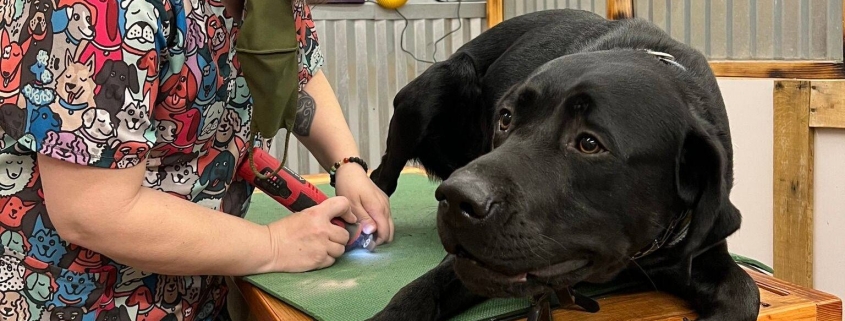How to Trim Your Pet’s Nails Safely
Have you ever wanted to trim your pet’s nails at home but were scared that you would damage the blood vessels inside the nail?
While trimming your dog’s or cat’s nails is pretty straightforward, there are some important details to remember so you can safely, and confidently, trim your pet’s nails on your own.
Your Pet’s Nail Anatomy
The first step of trimming your pet’s nails is understanding the anatomy of the nail. Start by looking at the top of your pet’s paw where the nail grows out and forward from the toe. This part of the nail is made of a tough, protective protein called keratin, the same protein found in animal hooves and human fingers and toenails.
Inside the keratin, from the tip of the toe to the middle of the nail, is a pulp filled with highly sensitive nerves and blood vessels called the quick. And right after the quick ends (towards the tip of the nail), you will see a bit more keratin. That extra keratin is what we want to focus on for trimming.
Choosing the Right Nail Trimmer
After you are comfortable with assessing your pet’s foot altogether, you will then move on to which trimmers would be the best fit for you and your pet. To purchase the right tool, it is best to understand each tool that is available.
- Scissor Clippers
This product is designed to function similarly to a normal pair of scissors. When you squeeze these to trim the nail the blades will come together and slice that part of the toenail off. This product is best used for medium to large breed pets. Scissor clippers are great for quick nail trimming and for first-time users. Some have a safety feature that helps you know when to stop before the quick.
- Guillotine Clippers
This product has a ring where you would insert your pet’s nail. Once you put your pet’s nail into this ring (taking caution not to include the quick) you will then squeeze the handles together and a blade will slide up and slice the tip of the nail off. Guillotine clippers are best used in small breed pets but aren’t recommended if you’re new to nail trimming or if your pet is uncomfortable with trims. Guillotine clippers may cause damage to the quick if the pet pulls away.
- Nail Grinder/Dremel
This product is best used in pets who struggle to cooperate with nail trimming sessions. A nail grinder is a powered nail file that spins at a high speed and will slowly file your pet’s nail down. This product is great as it can reduce the chances of hitting your pet’s quick in the nail. Pets tend to alert you when you may be too close to the quick when using a grinder. Another great reason to use a grinder is the fact that it does not leave the nail sharp. This product rounds out the nail to leave a smooth edge.
Expert Tip: We recommend keeping styptic powder nearby when trimming your pet’s nails. This powder will clot any bleeding that may happen if the quick is accidentally cut.
Once you can determine which product is best for both you and your pet, you then can start the trimming process.
Acclimating your Pet to Nail Trimming
If your pet has never had their nails trimmed before, it can seem like a scary event for them, and it’s important not to add additional stress. It may be helpful to work on desensitizing them to the process through several training sessions.
Ideally, we recommend introducing the nail trimming process at a very young age with your pet to get them comfortable with it being an easy, rewardable task. Stay calm and relaxed and start with touching and rubbing your pet’s toes, nails, and paw to get them comfortable with the process. Reward your pet – with training treats or verbal commands – after they stay calm and happy. Then try with one nail at a time and gradually work your way to doing more at a time. Eventually, you will be able to do all nails in one session and have an even stronger bond with them!
How often should I trim my pet’s nails?
This may vary depending on your pet. The average recommendation is anywhere between every 2-4 weeks. Dog’s nails are known to file down when walking on asphalt or hard surfaces and cats are known for sharpening their front nails on scratching posts and/or trees. But these processes do not always keep your pet’s nails at a safe length which is why nail trimming is always recommended.
Why are routine nail trims important?
When a pet’s nails are left to grow too long, there are multiple health issues that can arise. Long nails may overgrow back into paw pads which is very painful and can lead to infections in your pet’s paw pads. Overgrown nails can also lead to issues with their gait (the way they walk) as it can cause the feet to lay flatter than usual (imagine trying to keep weight off your toes when walking) and causes pressure on the bones in the ankle and leg, making it very uncomfortable for them to walk.
REFERENCES:
Randall, Samantha. “How to Choose the Right Dog Nail Clippers.” Top Dog Tips, 16 Nov. 2021, https://topdogtips.com/how-to-choose-the-right-dog-nail-clippers/.
Staff, AKC. “Nail Neglect Can Lead to Health Problems for Your Dog.” American Kennel Club, American Kennel Club, 23 Jan. 2018, https://www.akc.org/expert-advice/health/nail-neglect-can-lead-to-health-problems-for-your-dog/.
Palika, Liz. “Nail Anatomy 101: Keep Trims Safe, Not Scary.” Fear Free Happy Homes, 31 Mar. 2021, https://www.fearfreehappyhomes.com/nail-anatomy-101-keep-trims-safe-not-scary/.
Gauntt. “The Importance of a Pedicure.” VMBS News, 11 Mar. 2022, https://vetmed.tamu.edu/news/pet-talk/the-importance-of-a-peticure/.






